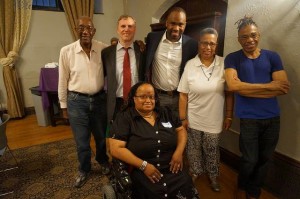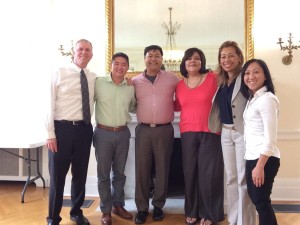Please Note: This Op-Ed first appeared in the Gay City News. You can find the original here.
After the Supreme Court’s decision for marriage equality in late June, 26 million friends of the LGBTQ community showed their support — at least on that issue —by putting a rainbow filter over their Facebook profile picture. Ultimately, the freedom to marry and #LoveWins became a “sexy” way for new allies to express their solidarity en masse. It was easy — by clicking a button the supporter and supported both could feel good basking in the glow of new equality and community. I won’t critique the value of the effort – I have to admit that when I saw the rainbow over the face of my staunchly Catholic straight cousin, it meant a lot.
But the gritty work that forges equity at the deepest crossroads of disenfranchisement and marginalization in our society often isn’t so sexy. What it takes to be an ally isn’t as easy as momentary solidarity and the click of a button. It takes commitment and sacrifice — putting a real stake in the ground. That’s why it’s noteworthy that at SAGE in recent years we’ve seen the emergence of true new leaders in the struggle for dignity and equity for LGBT elders. Even more importantly, some of the most game-changing new leaders have come from outside LGBT communities.
These stories of new leadership are a tribute to the courage and vision of new leaders for our cause — individuals who know how to “connect the dots” of social justice and are willing to do so. The stories also reflect emerging strategies of SAGE and other diverse elder communities — strategies that recognize how systems of oppression and privilege intersect, and turn that recognition into powerful action for change and greater equity.
Stepping Out for LGBT Elders of Color in New York
It’s not surprising that the country’s first full-fledged senior center for LGBT elders is located in Chelsea. The historical roots of New York City’s modern LGBT community, and of SAGE itself, are located right down the street in the West Village. Many elders from the Stonewall generation still live, as they have for decades, in the rent-controlled walk-up apartments that remain in these neighborhoods. While this is SAGE’s historical backyard, we also recognize that many of those who most need senior center services are LGBT elders of color — who live at the intersection of LGBTQ identity, race, advanced age, and in many cases poverty. Yet, for the most part, that’s not who was using the SAGE Center in Chelsea. The fact is that, apart from the valiant efforts of GRIOT Circle, the country’s only LGBT elders of color organization, the needs of LGBT elders of color have largely been disregarded. Most elders want to age in place — by continuing to reside in their neighborhoods and communities. For the vast majority of New York City’s LGBT elders of color, that means Harlem, the Bronx, Brooklyn, and Queens — not Chelsea.
SAGE’s recent advocacy efforts on behalf of low-income LGBT elders of color across New York City have attracted important new leaders to our cause. Support for our work historically has come predominantly from older white gays and lesbians and a small group of New York City Council members who make up the LGBT Caucus and understand the needs of the city’s LGBT communities. The successful advocacy for public funding for SAGE Centers across New York City broke the mold in part because the advocacy effort was led by Councilmember Ritchie Torres. True, Councilmember Torres is gay and a member of the LGBT Caucus. But he’s also young (at 27, the youngest member of the City Council), of Puerto Rican descent, a lifelong resident of the Bronx, and a champion of the city’s public housing that he was raised in. As somebody who connects the dots and understands the value of services that reflect the needs of diverse communities, Ritchie Torres clearly represents an important new leader for the cause of LGBT elders.
Even more striking is the crucial political support for the citywide LGBT elder initiative that came from the New York City Council as a whole, led by Council Speaker Melissa Mark-Viverito. The speaker is not a member of the LGBT community. But she is a progressive Latina leader who has become a powerful and visible champion for a New York City that prioritizes the needs of low-income people of color and who has argued forcefully for an equitable allocation of resources across the city’s neighborhoods. The combination of the speaker’s intersectional values and SAGE’s intersectional strategies resulted in the City Council making an unprecedented $1.5 million investment to open five new LGBT senior centers in Harlem, the Bronx, Brooklyn, Queens, and Staten Island.
Diverse Elder Communities Stand Up for Each Other at the National Level
Fortunately, this isn’t just a New York City story. In 2010, SAGE joined with leading people of color aging organizations like the National Hispanic Council on Aging and the National Asian Pacific Center on Aging to form the Diverse Elders Coalition, a national collaborative that engages in policy advocacy and community education on behalf of low income LGBT and people of color elders. For participating people of color organizations, the formation of the Coalition represented a decision to formally embrace LGBT older people and their needs as an important part of a diverse elder agenda.
For SAGE, joining the Coalition meant that issues like immigration reform, language competency in aging services, and disenfranchisement of Native American elders needed to become part of our advocacy agenda. Thus, when the National Indian Council on Aging and other people of color aging organizations confronted serious threats to elder workforce programs for their communities, SAGE made protection of those programs one of our policy priorities.
Similarly, people of color organizations in the Diverse Elders Coalition have strongly supported SAGE’s efforts to make the federal Older Americans Act LGBT-inclusive.
Here again, new leaders from beyond the LGBT community have emerged to take up the cause of LGBT elders. Dr. Yanira Cruz, the head of the National Hispanic Council on Aging, has personally championed the first-ever needs assessment of Latino LGBT elders and has participated in LGBTQ conferences across the country. Quyen Dinh and Doua Thor, the present and former heads of the Southeast Asia Resource Action Center, have been powerful and vocal advocates for LGBT-inclusion in national coalition work in the aging sector. These new leaders for SAGE’s cause have emerged not only as a result of their personal courage and values, but also as a consequence of an intentionally intersectional approach by SAGE and our sister organizations in the Diverse Elders Coalition.
So, we celebrate the 26 million rainbow profile photos on Facebook. But at SAGE, we save our deepest awe and respect for leaders like Speaker Melissa Mark-Viverito, Dr. Yanira Cruz, and Quyen Dinh, who have put a powerful stake in the ground for LGBT elders living at the intersection of sexual and gender identity, race, age, and class.
The opinions expressed in this article are those of the author and do not necessarily reflect those of the Diverse Elders Coalition.



